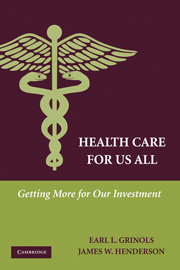Book contents
- Frontmatter
- Contents
- List of Tables
- List of Figures
- Preface
- Acknowledgments
- Executive Summary of the Targeted Intervention Plan
- PART I GOALS AND WORKING PRINCIPLES
- PART II BACKGROUND ECONOMICS AND ETHICS
- PART III APPLICATION
- PART IV PROTECTIVE MEASURES
- A Top Ten Goals for the American Health Care System
- B Badly Done Insurance Programs Can be Worse Than No Insurance
- C Incentive Symmetry and Intervention Principle
- D Plan Workability
- E Market Power Response to Insurance
- Glossary and Definitions
- References
- Index
Executive Summary of the Targeted Intervention Plan
Published online by Cambridge University Press: 05 June 2012
- Frontmatter
- Contents
- List of Tables
- List of Figures
- Preface
- Acknowledgments
- Executive Summary of the Targeted Intervention Plan
- PART I GOALS AND WORKING PRINCIPLES
- PART II BACKGROUND ECONOMICS AND ETHICS
- PART III APPLICATION
- PART IV PROTECTIVE MEASURES
- A Top Ten Goals for the American Health Care System
- B Badly Done Insurance Programs Can be Worse Than No Insurance
- C Incentive Symmetry and Intervention Principle
- D Plan Workability
- E Market Power Response to Insurance
- Glossary and Definitions
- References
- Index
Summary
Universal health care implies that everyone have health insurance and enough income to buy it. The intervention and incentive symmetry principles determine the efficient way to extend coverage. Patient-centered care and respect for the patient require that the patient be the center of the financial arrangements for health care. Health care is a private good, except for relatively limited public health aspects (e.g., epidemics and spread of disease). Standard welfare economics applied to economies with private and public goods suggests that healthy markets are the efficient mechanism for distributing private goods. Health care markets and health insurance markets have correctible problems that are part of the fix. Next, incentive compatibility for efficient income transfers so all can afford insurance suggests the need to distinguish between the capable and incapable needy. A modification of the Earned Income Tax Credit has desirable features for income transfers. With individuals all having enough income to buy health insurance, and being efficiently incentivized to do so, there remains only the issue of government budget management and framework sustainability. These are delivered by a provider revenue tax and the fact that consumers buy their insurance on an actuarially fair basis and buy their health care at competitive prices. These arrangements are indefinitely sustainable and treat all individuals fairly and alike. For most consumers, who surveys show are happy with their insurance and health care arrangements, nothing changes. The framework merely intervenes at the minimal number of points to accomplish all of its selected objectives efficiently.
- Type
- Chapter
- Information
- Health Care for Us AllGetting More for Our Investment, pp. xxi - xxviPublisher: Cambridge University PressPrint publication year: 2009



